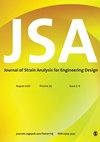用于估计拉伸、疲劳、断裂和裂纹扩展材料模型参数的小试样技术
IF 1.8
4区 工程技术
Q3 ENGINEERING, MECHANICAL
Journal of Strain Analysis for Engineering Design
Pub Date : 2021-06-15
DOI:10.1177/03093247211025208
引用次数: 7
摘要
小试件力学测试是一个令人兴奋和迅速发展的领域,在这个领域中,可以从相对少量的材料上进行的实验中观察到基本的变形行为。当源材料有限,无法进行足够数量的标准试样试验时,这些方法尤其有用。这种情况包括开发新材料或对在役部件进行例行维护/检查研究时,需要根据使用情况更新材料条件。与标准试样几何形状相比,小试样所经历的潜在更具挑战性的加载条件和复杂的应力状态,导致这些方法倾向于用于排序研究,而不是用于基本材料参数的确定。将样品分类为“小”可能是主观的,在目前的工作中,重点是审查利用特征尺寸小于50毫米的样品的测试方法。通过这样做,这里所做的观察将与工业服务监测问题相关,其中从操作组件中提取和测试小样本材料,以不损害结构完整性的方式。虽然最近大多数小试样测试技术的发展都集中在蠕变行为/性能的确定以及亚尺寸拉伸测试上,但这里的重点是确定特定拉伸、疲劳、断裂和裂纹扩展性能的小试样测试方法。这些领域目前在已发表的评论中代表性不足。这里讨论了标本和方法的适用性,以及相关的优点和缺点。本文章由计算机程序翻译,如有差异,请以英文原文为准。
Small specimen techniques for estimation of tensile, fatigue, fracture and crack propagation material model parameters
Small specimen mechanical testing is an exciting and rapidly developing field in which fundamental deformation behaviours can be observed from experiments performed on comparatively small amounts of material. These methods are particularly useful when there is limited source material to facilitate a sufficient number of standard specimen tests, if any at all. Such situations include the development of new materials or when performing routine maintenance/inspection studies of in-service components, requiring that material conditions are updated with service exposure. The potentially more challenging loading conditions and complex stress states experienced by small specimens, in comparison with standard specimen geometries, has led to a tendency for these methods to be used in ranking studies rather than for fundamental material parameter determination. Classifying a specimen as ‘small’ can be subjective, and in the present work the focus is to review testing methods that utilise specimens with characteristic dimensions of less than 50 mm. By doing this, observations made here will be relevant to industrial service monitoring problems, wherein small samples of material are extracted and tested from operational components in such a way that structural integrity is not compromised. Whilst recently the majority of small specimen test techniques development have focused on the determination of creep behaviour/properties as well as sub-size tensile testing, attention is given here to small specimen testing methods for determining specific tensile, fatigue, fracture and crack growth properties. These areas are currently underrepresented in published reviews. The suitability of specimens and methods is discussed here, along with associated advantages and disadvantages.
求助全文
通过发布文献求助,成功后即可免费获取论文全文。
去求助
来源期刊

Journal of Strain Analysis for Engineering Design
工程技术-材料科学:表征与测试
CiteScore
3.50
自引率
6.20%
发文量
25
审稿时长
>12 weeks
期刊介绍:
The Journal of Strain Analysis for Engineering Design provides a forum for work relating to the measurement and analysis of strain that is appropriate to engineering design and practice.
"Since launching in 1965, The Journal of Strain Analysis has been a collegiate effort, dedicated to providing exemplary service to our authors. We welcome contributions related to analytical, experimental, and numerical techniques for the analysis and/or measurement of stress and/or strain, or studies of relevant material properties and failure modes. Our international Editorial Board contains experts in all of these fields and is keen to encourage papers on novel techniques and innovative applications." Professor Eann Patterson - University of Liverpool, UK
This journal is a member of the Committee on Publication Ethics (COPE).
 求助内容:
求助内容: 应助结果提醒方式:
应助结果提醒方式:


